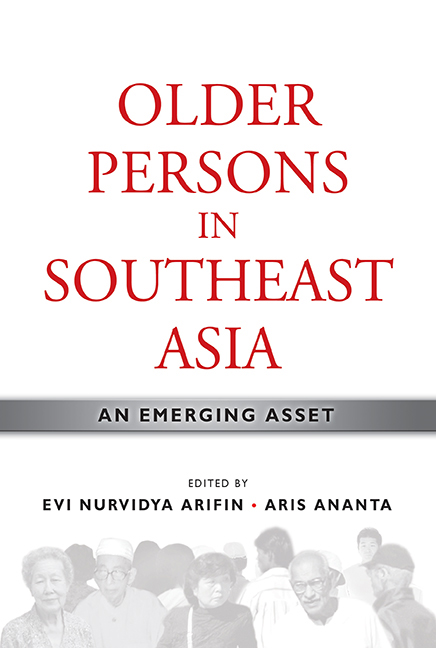Book contents
- Frontmatter
- Contents
- List of Tables
- List of Figures
- Foreword by Hal Hill
- Message from the Director
- Preface
- Contributors
- PART I INTRODUCTION
- 1 Older Persons in Southeast Asia: From Liability to Asset
- 2 Future Ageing in Southeast Asia: Demographic Trends, Human Capital, and Health Status
- PART II OLD-AGE INCOME SECURITY
- PART III EMPLOYMENT AND OTHER SOURCES OF FINANCIAL CONTRIBUTION
- PART IV AGEING, MIGRATION, AND DEVELOPMENT
- PART V ROLES OF GOVERNMENT AND CIVIL SOCIETY
- Index
2 - Future Ageing in Southeast Asia: Demographic Trends, Human Capital, and Health Status
from PART I - INTRODUCTION
Published online by Cambridge University Press: 21 October 2015
- Frontmatter
- Contents
- List of Tables
- List of Figures
- Foreword by Hal Hill
- Message from the Director
- Preface
- Contributors
- PART I INTRODUCTION
- 1 Older Persons in Southeast Asia: From Liability to Asset
- 2 Future Ageing in Southeast Asia: Demographic Trends, Human Capital, and Health Status
- PART II OLD-AGE INCOME SECURITY
- PART III EMPLOYMENT AND OTHER SOURCES OF FINANCIAL CONTRIBUTION
- PART IV AGEING, MIGRATION, AND DEVELOPMENT
- PART V ROLES OF GOVERNMENT AND CIVIL SOCIETY
- Index
Summary
Introduction
This chapter will try to draw a bigger picture about the likely future changes in age distribution in the countries of Southeast Asia, and highlight some key dimensions of the expected population ageing. It will focus on the demographic core of population ageing and also cover the changing education and health distributions of the population which are key dimensions for assessing the likely implications of these trends for individual countries. We will do so not in the conventional way of presenting already existing population projections for different countries (for example, taken from the U.N. population projections or national projections), but rather we will present innovative methods of population projections, such as probabilistic projections and multistate projections, and combine them with unique new data from a global ageing survey conducted by the Oxford Institute of Ageing funded by HSBC. These new data, combined with those more sophisticated projection methods, will allow us to address some of the key challenges of population ageing much more directly. We will present these analyses here for a few selected countries.
The chapter will be structured in the following way: First we present some new probabilistic population projections for Southeast Asia and specifically for Singapore. While these provide a comprehensive picture of what is likely and what is uncertain in terms of future population size and structures by age and sex, the ensuing sections of the paper also consider the changing educational structure of the population, which has major impacts ranging from effects on demographic trends themselves, to effects on health and income, among others. In the remainder of the chapter, we take a closer look at expected future trends in health and disability and how the explicit consideration of educational health differentials, together with a changing educational composition of the population, influences the outlook for ageing-related health concerns.
Probabilistic Population Projections for Southeast Asia and Singapore
There has been a major upsurge in probabilistic population projections recently because this field offers several advantages compared with conventional population projection variants or scenarios. As compared to the traditional U.N. high-medium-low variants, which are based only on alternative fertility assumptions and otherwise consider identical mortality and migration assumptions, probabilistic population projections consider the full range of uncertainties in all three demographic components of change.
- Type
- Chapter
- Information
- Older Persons in Southeast AsiaAn Emerging Asset, pp. 47 - 68Publisher: ISEAS–Yusof Ishak InstitutePrint publication year: 2009



